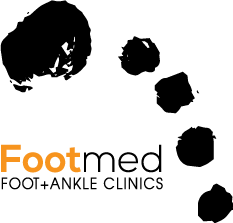Footmed Foot and Ankle Clinic provides a variety of quality services to treat bunions. We welcome patients from across Adelaide and Murray Bridge.
What are bunions?
Your big toe has turned towards your second toe causing a bony bump to stick out at the side of your foot (bunion). The skin and tissue on the bump of the bunion can become inflamed, swollen and painful. A bunion is more than a ‘bump’; it is a progressive disorder that often involves arthritis of the joint. As the deformity progresses the big toe has moved so far across that it can abut the second toe creating hammertoe deformities. The amount of pain and disability experienced with less severe deformity is similar to a more severe deformity.
Bunion causes
Bunions are most often caused by faulty mechanics of the foot. The deformity runs in families, but it is the foot type that is hereditary, not the bunion. Certain foot types make a person prone to developing a bunion. Injury can be a cause, especially if just one foot is involved. Although wearing shoes that crowd the toes won’t actually cause bunions in the first place, it can make the deformity progressively worse. That means you may experience symptoms sooner.
What does bunion surgery involve?
The operation involves removing the enlarged portion of bone. Ligaments and tendons that are too tight around the joint are released. The metatarsal bone in the big toe is then cut and shifted to a normal alignment that also makes the forefoot narrower. The cut bone is held in place with a screw or wire, which is not removed unless it causes problems. The loose, stretched out joint capsule is then tightened completing the soft tissue balance required for your deformity. Both feet can be operated on at the same time, but this does further limit mobility after surgery.
The operation is usually day surgery but you may need to stay overnight – the surgeon will discuss this with you. You will be given a special sandal to wear over bandages, which you must wear whenever you want to walk. The sandal must be worn for four weeks.
For the first 2-4 weeks we recommend restricted weight bearing of 15-20 minutes to every hour you are awake. When resting, elevate your leg on 2 pillows and take the pain medication prescribed for you. You will be asked to do some foot and knee exercises during this time to stimulate circulation. The bandages will need to be kept dry. You will be given an appointment to return to have the foot redressed in one week. You may be able to return to work from 4-8 weeks after the operation, depending on whether you need to stand or walk around a lot for your job. After 4 weeks you may begin increasing your activity to tolerance using sneaker type footwear, and resting/elevating the foot as required.
The operation has been shown to be predictable and reliable with good to excellent patient satisfaction of 92% after 2 years and 87% satisfaction after 12 years. No other procedures have been shown to be superior to the Chevron osteotomy in the Cochrane review for the surgical treatment of bunions.
- Swelling (for up to 6-9 months)
- Infection (smoking increases risk by 16X)
- Wound problems (slow to heal)
- Scar sensitivity
- Nerve Injury (nerves can be bruised which resolves but you can be left with permanent numbness)
- CRPS = Complex Regional Pain Syndrome (Rare <1%)
- Deep vein thrombosis (clot in deep vein in the legs)
- Continuing symptoms (if the toe still remains a problem, other surgical options may need to be considered)
Following surgery allow the foot a good 12 months to fully settle down. The surgeon will explain any particular individual risks that you may have.

